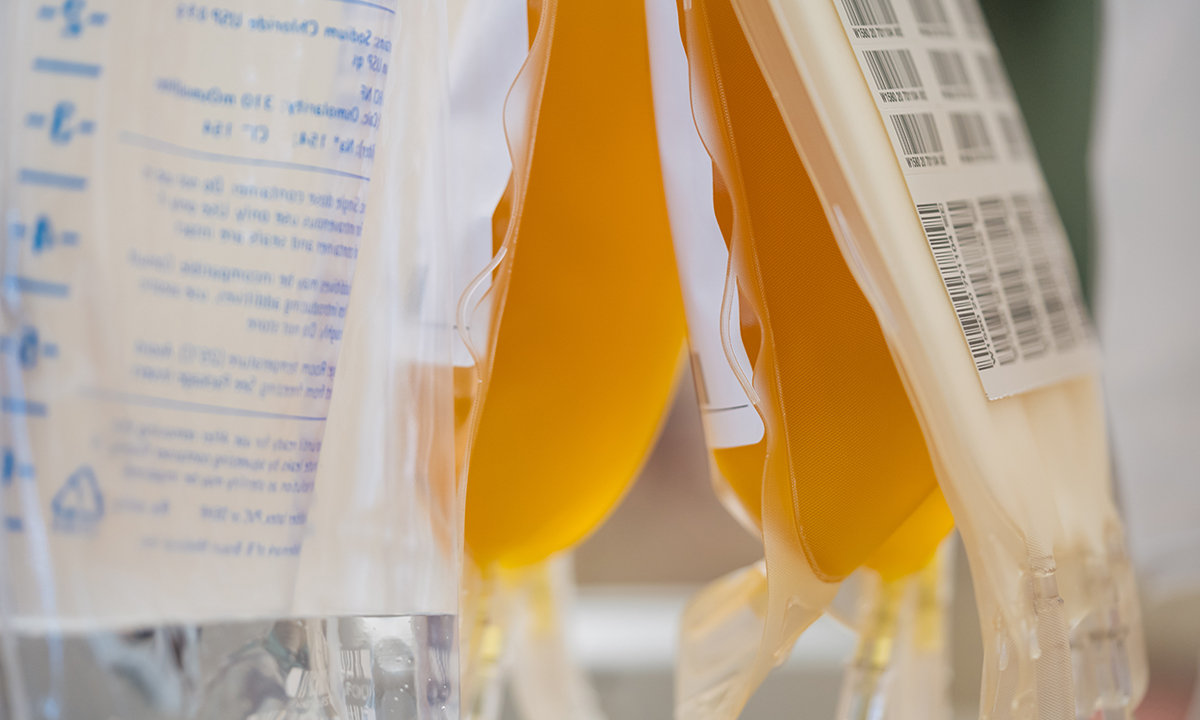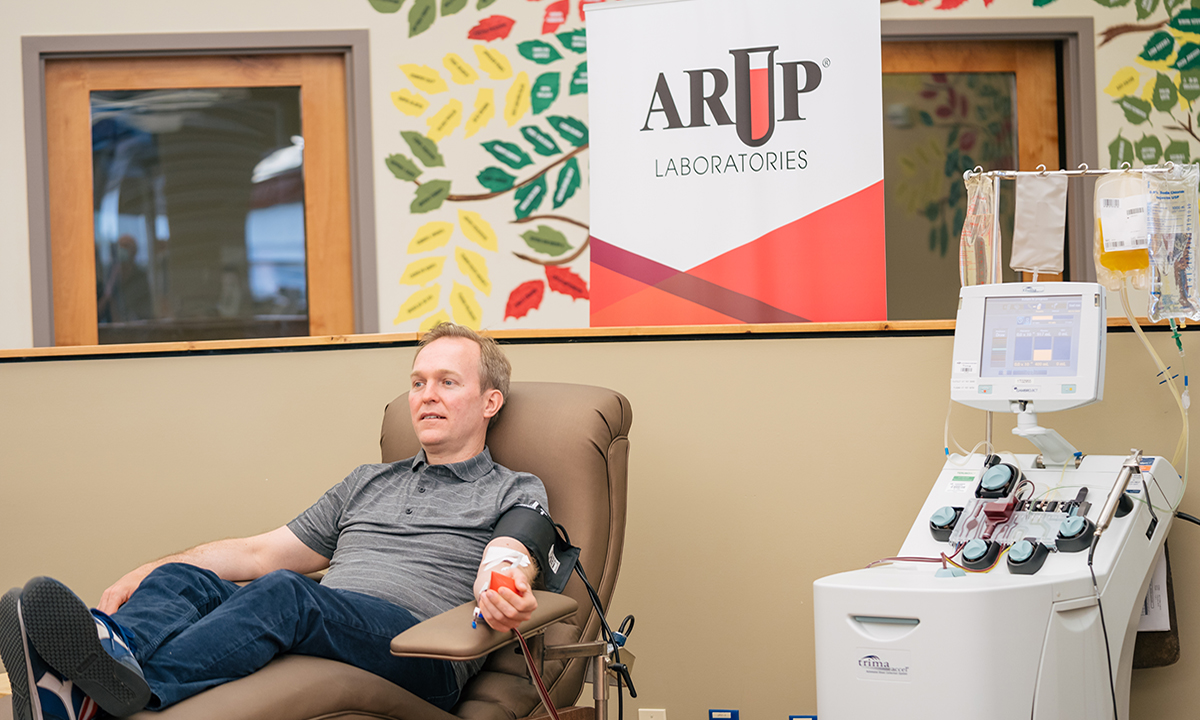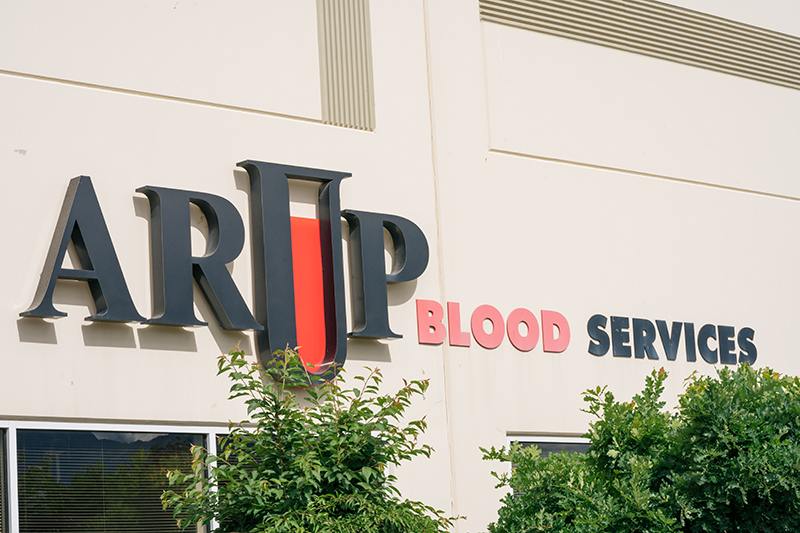
An ARUP/University of Utah Health study to determine whether convalescent plasma from individuals who have recovered from COVID-19 is a safe and effective treatment for patients with the disease earned some time in the spotlight on Thursday, May 21, when Democratic Utah Rep. Ben McAdams donated plasma to the project.
The donation at ARUP Blood Services Sandy Donor Center was McAdams’ second; the congressman also donated convalescent plasma in April after recovering from COVID-19.
“We all need to do our part to protect one another from this virus,” McAdams said. “I’m fortunate that I can do a little more than most because I have antibodies I can share that may help someone suffering from the disease.”

The project, which researchers hope will soon become part of a formal clinical trial, is a collaboration between Robert Blaylock, MD, and Ryan Metcalf, MD, medical directors of ARUP Blood Services and U of U Hospital Transfusion Services, and Emily Spivak, MD, MHS, U of U associate professor of medicine in the Division of Infectious Diseases. It is one of several projects on which ARUP and U of U Health are collaborating to help advance knowledge about COVID-19.
Convalescent plasma is blood plasma collected from people who have recovered from an infectious disease—in this case, COVID-19. A convalescent donor’s plasma contains circulating antibodies to SARS-CoV-2 that, when transfused, could neutralize the virus, preventing further replication or halting ongoing tissue damage, although Spivak points out that this has yet to be demonstrated in a clinical trial.
“In general, the role that antibodies play in controlling the virus is yet to be established, so careful, rigorous studies of convalescent plasma transfusion would help to clarify some of that,” she said.
Convalescent plasma has a long history of use in past outbreaks, with some studies suggesting that it is a safe treatment and can lead to an improvement in patient outcomes. However, this has not been studied rigorously or proven because data from randomized controlled trials are lacking. Perhaps the most prominent use of convalescent plasma was during the 1918 influenza outbreak. It was used more recently in 2003, during the SARS-CoV-1 outbreak, and in 2009, during the H1N1 outbreak.
ARUP started collecting COVID-19 convalescent plasma over a month ago using apheresis technology, which is more robust than the whole blood method used for collecting donor plasma. With apheresis technology, ARUP is able to centrifuge the blood during collection and take only the plasma component, returning the red blood cells to the donor. Each donation could be used to transfuse up to four patients with COVID-19.
Metcalf estimates that 75-100 people have offered to donate COVID-19 convalescent plasma so far. “You definitely get this general sense that people want to do everything they can to help the community out during this challenging time,” he said. “We’ve had so many people reach out who have had COVID-19 and recovered and are interested in donating, and that’s been incredible to see.”
To be eligible to donate plasma, individuals must meet the usual rigorous blood donation requirements as well as COVID-19-specific requirements: A donor must have documented evidence of COVID-19 based on either a diagnostic test or a serologic test after recovery, have fully recovered from the illness, and must be asymptomatic for at least 14 days before donation. The FDA also requires a neutralizing antibody titer of at least 1:80 dilution. Because COVID-19 neutralizing antibody tests are not currently available, a retention sample must be stored for later testing.
Metcalf believes ARUP and U of U Health are in a good position to participate in a clinical trial because ARUP has carefully prioritized donations from individuals such as McAdams who are understood to have the highest numbers of antibodies. These tend to be people who were sick enough to be hospitalized or admitted to an intensive care unit.
McAdams contracted COVID-19 in March, and spent eight days in the hospital.
He and other individuals who were sicker generally demonstrate a stronger antibody signal than those who had a positive COVID-19 antibody test result, but were never symptomatic. When COVID-19 IgG antibody test results are available, ARUP pays careful attention to the IgG signals, or index values. “Not every donor site excludes potential donors by these antibody signals, and this approach may set ARUP apart from other convalescent plasma collection sites,” says Metcalf.
Now that ARUP has built an inventory of COVID-19 convalescent plasma, Metcalf and Spivak have turned their attention toward the best way to get it to patients while also advancing scientific understanding of the virus.

COVID-19 convalescent plasma is regulated by the FDA as an investigational product, and three pathways are available through the FDA for administering and/or studying the use of COVID-19 convalescent plasma. One pathway is through a single patient emergency investigation new drug (IND) application.
The second pathway is through a national expanded access protocol program administered through the Mayo Clinic. This protocol enables patients with confirmed COVID-19 with moderate to severe disease to be treated with convalescent plasma if they meet FDA-defined clinical criteria and provide informed consent.
Through this program, U of U Health has transfused two inpatients with COVID-19 convalescent plasma from ARUP’s supply. Under this program, outcome data will be collated nationally and analyzed to gain insights about the therapy.
The third pathway, and the one of most interest to many academic medical centers with access to convalescent plasma, is through an FDA-approved multicenter randomized controlled clinical trial, which is the only way to truly determine treatment safety and efficacy. Several of these trials are in development or ongoing and focus on a variety of study participants, including exposed high-risk individuals receiving prophylactic treatment, patients with mild COVID-19 disease, and patients with moderate or severe disease.
Metcalf explains that convalescent plasma is thought to work best earlier in the disease course, or possibly prophylactically in highly susceptible individuals such as exposed health care workers or family caregivers of patients with COVID-19.
What might happen, he wonders, if a patient came to the emergency department in the early stages of COVID-19 with a mild or less severe form of the disease and was transfused before being discharged? Would a transfusion of convalescent plasma at this point in the disease course mitigate the severity of illness and possibly prevent the need for subsequent medical care? “These are the types of questions our community is interested in answering right now,” Metcalf said.
Spivak is careful to point out that they don’t yet have enough experience with COVID-19 convalescent plasma to say if it can work in this way or not, but she’s optimistic about its potential, particularly in patients who are not seriously ill.
“I think that may be a general theme for all COVID-19-related therapies—that we probably need to catch people before they get too sick and while they’re in the earlier stages of viral replication rather than later when they have intense immune responses to the virus or fibrotic lung disease,” she said. “I suspect convalescent plasma may play some role in modifying the severity of disease, but it has to be more rigorously studied to prove that.”
















